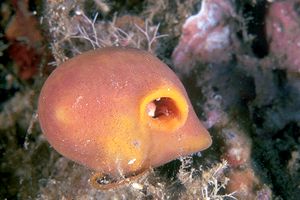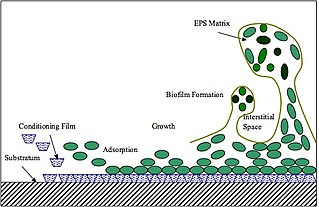
Chemotaxis is the movement of an organism or entity in response to a chemical stimulus. Somatic cells, bacteria, and other single-cell or multicellular organisms direct their movements according to certain chemicals in their environment. This is important for bacteria to find food by swimming toward the highest concentration of food molecules, or to flee from poisons. In multicellular organisms, chemotaxis is critical to early development and development as well as in normal function and health. In addition, it has been recognized that mechanisms that allow chemotaxis in animals can be subverted during cancer metastasis. The aberrant chemotaxis of leukocytes and lymphocytes also contribute to inflammatory diseases such as atherosclerosis, asthma, and arthritis. Sub-cellular components, such as the polarity patch generated by mating yeast, may also display chemotactic behavior.

Arabidopsis (rockcress) is a genus in the family Brassicaceae. They are small flowering plants related to cabbage and mustard. This genus is of great interest since it contains thale cress, one of the model organisms used for studying plant biology and the first plant to have its entire genome sequenced. Changes in thale cress are easily observed, making it a very useful model.

A biofilm comprises any syntrophic consortium of microorganisms in which cells stick to each other and often also to a surface. These adherent cells become embedded within a slimy extracellular matrix that is composed of extracellular polymeric substances (EPSs). The cells within the biofilm produce the EPS components, which are typically a polymeric conglomeration of extracellular polysaccharides, proteins, lipids and DNA. Because they have three-dimensional structure and represent a community lifestyle for microorganisms, they have been metaphorically described as "cities for microbes".
In biology, quorum sensing or quorum signaling (QS) is the ability to detect and respond to cell population density by gene regulation. Quorum sensing is a type of cellular signaling, and more specifically can be considered a type of paracrine signaling. However, it also contains traits of both autocrine signaling: a cell produces both the autoinducer molecule and the receptor for the autoinducer. As one example, QS enables bacteria to restrict the expression of specific genes to the high cell densities at which the resulting phenotypes will be most beneficial, especially for phenotypes that would be ineffective at low cell densities and therefore too energetically costly to express. Many species of bacteria use quorum sensing to coordinate gene expression according to the density of their local population. In a similar fashion, some social insects use quorum sensing to determine where to nest. Quorum sensing in pathogenic bacteria activates host immune signaling and prolongs host survival, by limiting the bacterial intake of nutrients, such as tryptophan, which further is converted to serotonin. As such, quorum sensing allows a commensal interaction between host and pathogenic bacteria. Quorum sensing may also be useful for cancer cell communications.

A biogenic substance is a product made by or of life forms. While the term originally was specific to metabolite compounds that had toxic effects on other organisms, it has developed to encompass any constituents, secretions, and metabolites of plants or animals. In context of molecular biology, biogenic substances are referred to as biomolecules. They are generally isolated and measured through the use of chromatography and mass spectrometry techniques. Additionally, the transformation and exchange of biogenic substances can by modelled in the environment, particularly their transport in waterways.

N-Acyl homoserine lactones are a class of signaling molecules involved in bacterial quorum sensing, a means of communication between bacteria enabling behaviors based on population density.

Suberites domuncula is a species of sea sponge belonging to the family Suberitidae.
Prostaglandin receptors or prostanoid receptors represent a sub-class of cell surface membrane receptors that are regarded as the primary receptors for one or more of the classical, naturally occurring prostanoids viz., prostaglandin D2,, PGE2, PGF2alpha, prostacyclin (PGI2), thromboxane A2 (TXA2), and PGH2. They are named based on the prostanoid to which they preferentially bind and respond, e.g. the receptor responsive to PGI2 at lower concentrations than any other prostanoid is named the Prostacyclin receptor (IP). One exception to this rule is the receptor for thromboxane A2 (TP) which binds and responds to PGH2 and TXA2 equally well.

In taxonomy, Roseobacter is a genus of the Rhodobacteraceae. The Roseobacter clade falls within the {alpha}-3 subclass of the class Alphaproteobacteria. The first strain descriptions appeared in 1991 which described members Roseobacterlitoralis and Roseobacterdenitrificans, both pink-pigmented bacteriochlorophyll a-producing strains isolated from marine algae. The role members of the Roseobacter lineage play in marine biogeochemical cycles and climate change cannot be overestimated. Roseobacters make up 25% of coastal marine bacteria and members of this lineage process a significant portion of the total carbon in the marine environment. Roseobacter clade plays an important role in global carbon and sulphur cycles. It can also degrade aromatic compounds, uptake trace metal, and form symbiotic relationship. In term of its application, Roseobacter clade produces bioactive compounds, has been used widely in aquaculture and quorum sensing.

Extracellular polymeric substances (EPSs) are natural polymers of high molecular weight secreted by microorganisms into their environment. EPSs establish the functional and structural integrity of biofilms, and are considered the fundamental component that determines the physicochemical properties of a biofilm. EPS in the matrix of biofilms provides compositional support and protection of microbial communities from the harsh environments. Components of EPS can be of different classes of polysaccharides, lipids, nucleic acids, proteins, lipopolysaccharides, and minerals.
Autoinducers are signaling molecules that are produced in response to changes in cell-population density. As the density of quorum sensing bacterial cells increases so does the concentration of the autoinducer. Detection of signal molecules by bacteria acts as stimulation which leads to altered gene expression once the minimal threshold is reached. Quorum sensing is a phenomenon that allows both Gram-negative and Gram-positive bacteria to sense one another and to regulate a wide variety of physiological activities. Such activities include symbiosis, virulence, motility, antibiotic production, and biofilm formation. Autoinducers come in a number of different forms depending on the species, but the effect that they have is similar in many cases. Autoinducers allow bacteria to communicate both within and between different species. This communication alters gene expression and allows bacteria to mount coordinated responses to their environments, in a manner that is comparable to behavior and signaling in higher organisms. Not surprisingly, it has been suggested that quorum sensing may have been an important evolutionary milestone that ultimately gave rise to multicellular life forms.

Lactonase (EC 3.1.1.81, acyl-homoserine lactonase; systematic name N-acyl-L-homoserine-lactone lactonohydrolase) is a metalloenzyme, produced by certain species of bacteria, which targets and inactivates acylated homoserine lactones (AHLs). It catalyzes the reaction

Asparagopsis armata is a species of marine red algae, in the family Bonnemaisoniaceae. English name(s) include red harpoon weed. They are multicellular eukaryotic organisms. This species was first described in 1855 by Harvey, an Irish botanist who found the algae on the Western Australian coast. A. armata usually develops on infralittoral rocky bottoms around the seawater surface to around 40m of depth. Marine algae like A. armata are considered "autogenic ecosystem engineers" as they are at the very bottom of the food chain and control resource availability to other organisms in the ecosystem.
Cell–cell interaction refers to the direct interactions between cell surfaces that play a crucial role in the development and function of multicellular organisms. These interactions allow cells to communicate with each other in response to changes in their microenvironment. This ability to send and receive signals is essential for the survival of the cell. Interactions between cells can be stable such as those made through cell junctions. These junctions are involved in the communication and organization of cells within a particular tissue. Others are transient or temporary such as those between cells of the immune system or the interactions involved in tissue inflammation. These types of intercellular interactions are distinguished from other types such as those between cells and the extracellular matrix. The loss of communication between cells can result in uncontrollable cell growth and cancer.

Chemical defense is a strategy employed by many organisms to avoid consumption by producing toxic or repellent metabolites or chemical warnings which incite defensive behavioral changes. The production of defensive chemicals occurs in plants, fungi, and bacteria, as well as invertebrate and vertebrate animals. The class of chemicals produced by organisms that are considered defensive may be considered in a strict sense to only apply to those aiding an organism in escaping herbivory or predation. However, the distinction between types of chemical interaction is subjective and defensive chemicals may also be considered to protect against reduced fitness by pests, parasites, and competitors. Repellent rather than toxic metabolites are allomones, a sub category signaling metabolites known as semiochemicals. Many chemicals used for defensive purposes are secondary metabolites derived from primary metabolites which serve a physiological purpose in the organism. Secondary metabolites produced by plants are consumed and sequestered by a variety of arthropods and, in turn, toxins found in some amphibians, snakes, and even birds can be traced back to arthropod prey. There are a variety of special cases for considering mammalian antipredatory adaptations as chemical defenses as well.
Alteromonas macleodii is a species of widespread marine bacterium found in surface waters across temperate and tropical regions. First discovered in a survey of aerobic bacteria in 1972, A. macleodii has since been placed within the phylum Pseudomonadota and is recognised as a prominent component of surface waters between 0 and 50 metres. Alteromonas macleodii has a single circular DNA chromosome of 4.6 million base pairs. Variable regions in the genome of A. macleodii confer functional diversity to closely related strains and facilitate different lifestyles and strategies. Certain A. macleodii strains are currently being explored for their industrial uses, including in cosmetics, bioethanol production and rare earth mining.
Acyl-homoserine-lactone synthase is an enzyme with systematic name acyl-(acyl-carrier protein):S-adenosyl-L-methionine acyltranserase . This enzyme catalyses the following chemical reaction

Violacein is a naturally-occurring bis-indole pigment with antibiotic properties. Violacein is produced by several species of bacteria, including Chromobacterium violaceum, and gives these organisms their striking purple hues. Violacein shows increasing commercially interesting uses, especially for industrial applications in cosmetics, medicines and fabrics.
Podospora appendiculata is a coprophilous fungus that is most commonly found in the dung of lagomorphs, such as hares and rabbits, in temperate to warm climates. A member of the division Ascomycota, P. appendiculata is characterized by ovoid, hair-studded perithecia which can bear a distinctive violaceous colouring and peridia which are coriaceous, or leathery, in texture. Podospora appendiculata has been shown to produce three compounds with antimicrobial properties.
Lone Gram is Danish microbiologist known for her work in bacterial physiology, microbial communication, and biochemicals that originate from bacterial cultures. She is an elected member of the Royal Danish Academy of Sciences and Letters and has received the Order of the Dannebrog.











